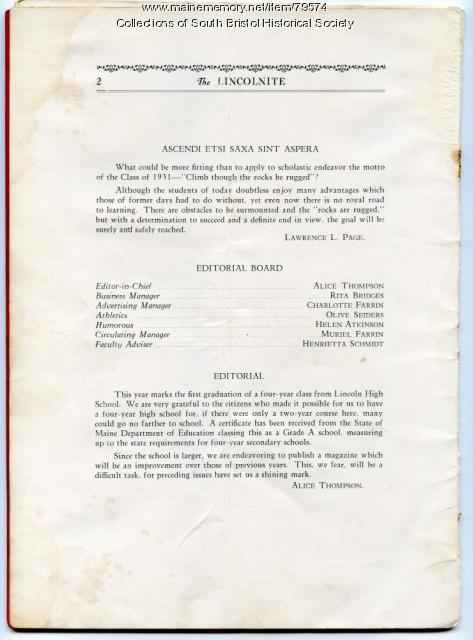Keywords: rural school
Item 70282
Dyar rural school building, Strong, ca. 1910
Contributed by: Strong Historical Society Date: circa 1910 Location: Strong Media: Photographic print
Item 79574
Lincolnite yearbook editorial page, South Bristol, 1931
Contributed by: South Bristol Historical Society Date: 1931 Location: South Bristol Media: Ink on paper
Item 150784
Phillips Rural School Buiding & Outhouse, Phillips, 1897
Contributed by: Maine Historical Society Date: 1897 Location: Phillips Client: Town of Phillips Architect: Coombs, Gibbs, and Wilkinson Architects
Exhibit
Reading, Writing and 'Rithmetic: Brooklin Schools
When Brooklin, located on the Blue Hill Peninsula, was incorporated in 1849, there were ten school districts and nine one-room school houses. As the years went by, population changes affected the location and number of schools in the area. State requirements began to determine ways that student's education would be handled. Regardless, education of the Brooklin students always remained a high priority for the town.
Exhibit
Public education has been a part of Maine since Euro-American settlement began to stabilize in the early eighteenth century. But not until the end of the nineteenth century was public education really compulsory in Maine.
Site Page
Strong, a Mussul Unsquit village - Early Schools
"… Exhibits The early schools of Strong were called rural or district schools and were situated in various areas of the community to accommodate the…"
Site Page
Strong, a Mussul Unsquit village - Village Schools
"Another era in education in northern Franklin County began. Next Page (Blue Ribbon School) Return to previous page Return to Online Exhibits"
Story
Ann Luginbuhl - One-to-one in a small rural school
by MLTI Stories of Impact Project
Ann Luginbuhl describes the arrival of one-to-one in a K-8 school of 30 students.
Story
Ronald Ramsay - MLTI impact in Washington County's MSAD 37
by MLTI Stories of Impact Project
Ronald Ramsay describes the impact of the arrival of on-to-one laptops in MSAD 37.
Lesson Plan
Teddy Roosevelt, Millie, and the Elegant Ride Companion Curriculum
Grade Level: 3-5, 6-8
Content Area: Social Studies
These lesson plans were developed by Maine Historical Society for the Seashore Trolley Museum as a companion curriculum for the historical fiction YA novel "Teddy Roosevelt, Millie, and the Elegant Ride" by Jean. M. Flahive (2019). The novel tells the story of Millie Thayer, a young girl who dreams of leaving the family farm, working in the city, and fighting for women's suffrage. Millie's life begins to change when a "flying carpet" shows up in the form of an electric trolley that cuts across her farm and when a fortune-teller predicts that Millie's path will cross that of someone famous. Suddenly, Millie finds herself caught up in events that shake the nation, Maine, and her family. The lesson plans in this companion curriculum explore a variety of topics including the history of the trolley use in early 20th century Maine, farm and rural life at the turn of the century, the story of Theodore Roosevelt and his relationship with Maine, WWI, and the flu pandemic of 1918-1920.
Lesson Plan
Longfellow Studies: The Village Blacksmith - The Reality of a Poem
Grade Level: 6-8, 9-12
Content Area: English Language Arts, Social Studies
"The Village Blacksmith" was a much celebrated poem. Written by Henry Wadsworth Longfellow, the poem appeared to celebrate the work ethic and mannerisms of a working man, the icon of every rural community, the Blacksmith. However, what was the poem really saying?















